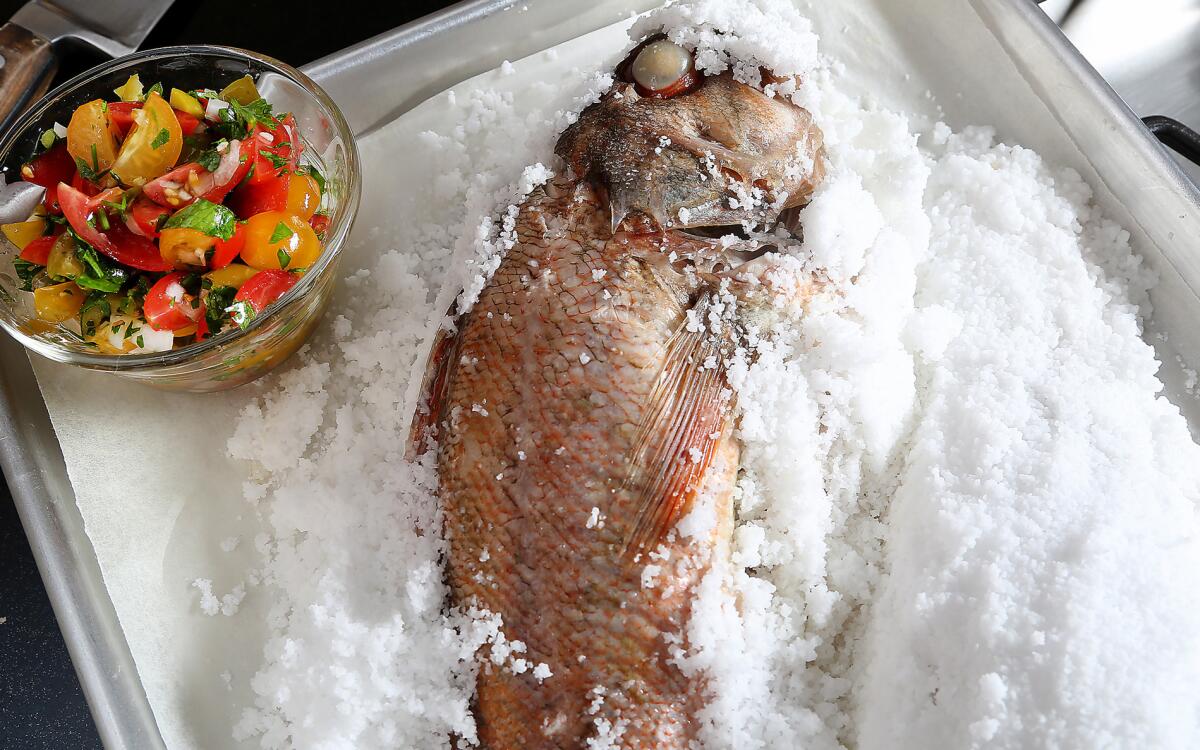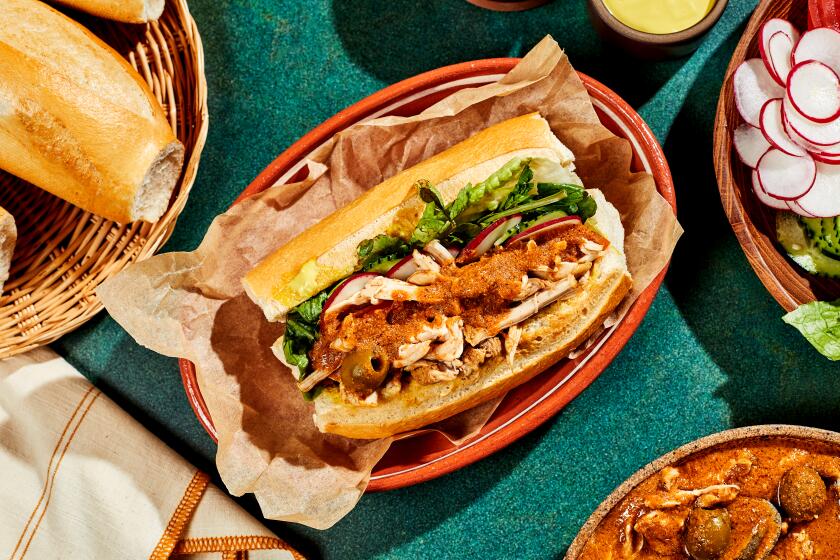Salt-roasted rockfish with tomato-olive salsa

At the Dory Fleet market in Newport Beach, local independent fishermen have been selling their catch directly to the public for more than 100 years. If anything, it’s more popular today than it has ever been. The market, founded in 1891 and declared a historical landmark, has seen its share of ups and downs. Two of its members have been lost at sea, and tight new regulations designed to protect some overfished species have made it tough for fishermen to make a living. But today, the market is thriving, and so are the hardy survivors who make it happen.
Leslie Leal
Leslie Leal is explaining to a customer the difference between yellowtail and yellowfin tuna. “Yellowfin is a Cadillac, yellowtail is a Volkswagen,” she says. Convinced, the shopper ponies up $148 in cash for the almost 25-pound tuna. Leal asks how he wants it prepared, then shoves it to the two workers beside her for cleaning. Within minutes, the tuna is reduced to steaks, with its innards collected in a small bucket. Shopper John
Nguyen says his mother cures them in the sun, then cooks them to make a fantastic dipping sauce for vegetables.
Just another happy customer for Leal, who is well into her fourth decade at the market. “I’ve been working here 43 years,” she says, standing in front of a table piled with sculpin, two kinds of rock fish, sablefish (black cod), yellowtail and yellowfin tuna (all $6 a pound). “I married a dory fisherman when I was 21 and wanted to help out. He just passed away, and I sold the business to this young man.” She’s talking about Scott Breneman, himself a third-generation fisherman, originally working on the small boats called dories. “He saved my life and gave me a job. I hated to leave the market. I raised my two daughters here.”
When Leal started at the market, there were 16 fishermen in the dory fleet. Now, she says, there are six. “We had two die, but most
of them left because they just couldn’t do it. You either can do it or you can’t, and as a fisherman you find that out pretty quickly. Making a living off the ocean, only the tough ones remain.”
The number of fishermen isn’t the only thing that’s changed. Over the years so has the number of fish. “At first we had plenty of fish,” Leal says. “In the ‘70s we were even catching fish to sell off the pier. That went on for a good 20 years, then you could see the decline. The catches got smaller and smaller. Then [the California Department of] Fish and Game got involved. You’ve seen all the regulations they put in. At first, it was rough for fishermen and everyone complained, but now that they can see it’s working — that we’re catching fish that we haven’t seen for a while — then they just shut right up.”
The Voyatzis family
In 1981 Stratos Voyatzis — a sculptor of Greek and Armenian extraction newly emigrated from Russia and in need of a job to support his growing family — went fishing with a friend at Newport Pier. He met an Italian fisherman who gave him a job cleaning fish. Now there are three generations of the Voyatzis family working at the dory market: Stratos and his wife, Vailia, their grown sons, Coco and Marco, Marco’s wife, Nicki, and Coco’s son Dimitri.
“I was 9 years old when I started working here baiting hooks,” Marco says. “Summertime I’d bait hooks three months, then when school started, I’d go there and then go back to work after school baiting hooks. When I was 14, I started going out on the boat and helping out. When I was 16 or 17, I was already running my own boat.” Today, Marco’s table selling live spot prawns ($20 a pound) is one of the market’s hottest draws. Customers stand in line for an hour — at 6 a.m. on a Saturday morning.
When he started, the family had one boat, which they’d roll out through the surf to fish just offshore. “You’d go out really close, come in at 8 in the morning, roll the boats back up, sell your stuff, and then maybe go back out in the afternoon,” he says. Now the family has four boats, bringing in trapped shrimp, crab and lobster from as far as 70 miles out, and line-caught rock fish, sculpin, sanddab and black cod from near-shore (all fish are $6 a pound).
“We went through some pretty tough times with regulations, it closed some fisheries down and really almost killed the fleet. But somehow we stuck it out and turned it all around. Now it’s good,” Marco says. “Our kids, if they want to do this, they actually have a future to be able to support their families. We sacrificed a little for the first few years, but in the end it was a lot better for the fishery.”
‘Crabby’ Steve Escobar
“Crabby” Steve Escobar is the other hot number at the market — if anything, the lines for his rock crabs and whelks ($2 a pound) are even longer than those for spot prawns. He’s been selling at the market since 1991 and is the group’s main voice online with his Twitter account (@doryfleet), which has almost 1,000 followers.
“Social media really helps,” he says, sounding like any other modern marketer. “That’s when this market really started to take off. More important, though, we focus on taking care of our customers.” Escobar’s rock crabs — separated male and female because some shoppers prefer the egg-laden females — are almost an automatic sale with many of the shoppers. But the whelks have taken a little more convincing. “When I first started selling snails, not many people were buying them,” he says. “Then I put up a sign saying ‘Poor man’s abalone’ and that helped a lot.”
The current success of the market has been great for business but something of a mixed blessing in other ways. “It used to be that I knew 80 to 90% of my customers on a first-name basis. Now it’s more like 10%. It’s just gotten crazy, and
a lot of my older customers stay away because they don’t want to have to stand in line. Business is great, but it’s kind of bittersweet.”
Stephanie Mutz
Santa Barbara diver Stephanie Mutz drives down to Newport every Saturday morning, the back of her car loaded with 500 pounds of sea urchins and sea cucumbers ($5 apiece). At the market she’s met by her mother and father, who help her sell and, if asked, will crack open and clean your urchins for a perfect seaside breakfast.
Mutz is something of a sea star. Her urchins are name-checked on the menus at David Lentz’s Hungry Cat restaurants and at Michael Cimarusti’s Providence and Connie and Ted’s. She drives down to Newport every Saturday, she says, because she’s engaged to Crabby Steve. “That’s the only way I’d get to see him. If you can’t beat ‘em, join ‘em.”
But she also appreciates the atmosphere in Newport. “I really enjoy the cultural dynamic here, the cultural diversity. In Santa Barbara, people say ‘What is that? It looks gross. Ewwww.’ Here they say, ‘What is that? How do you cook it? I’ll take 10.’”
Heat the oven to 400 degrees. Line a jellyroll pan with parchment paper. Stuff the cavities of the fish with the bay leaves.
Place the salt in a large bowl and stir in the water until the texture is that of gritty snow. On the lined jellyroll pan, spread some of the salt in a layer about 1/4-inch deep that is roughly the size of both fish. Place the fish on top of that, then mound the rest of the salt on top, covering them completely in a smooth, even layer. Roast the salt-encased fish in the oven for 20 minutes.
While the fish is roasting, prepare the salsa. Cut the tomatoes in quarters and place them in a bowl with the onion, garlic, serrano pepper, capers, olives, oregano and parsley. Mix in the olive oil and lime juice, and season with 1 teaspoon salt or to taste.
After 20 minutes, remove the fish from the oven and let stand 5 more minutes to finish cooking. With a sturdy metal spoon or chef’s knife, chip a crack around the base of the salt crust and carefully lift off the top. Use a dry pastry brush to brush away any salt on the surface of the fish.
Using a long spatula, carefully lift the fish onto a serving platter, turning it over in the process so you can brush away the salt on the underside. If you prefer, you can skin the fish — the skin will be quite loose and will come up easily.
Use the spatula to remove the nest of bones under the dorsal fin. Carefully lift off the top fillet, using the tip of the spatula to cut from the top of the fish along the backbone. Carefully lift the fillet to a second, warm serving platter, skin-side down, and remove any loose bones that are still attached.
Lift the tail of the fish, and the spine and ribs will come free. Cut behind the head again to free the second fillet. Transfer this fillet to the platter, skin-side down, and remove any loose bones. Spoon some of the sauce over the fillets and pass the rest at the table.
Get our Cooking newsletter.
Your roundup of inspiring recipes and kitchen tricks.
You may occasionally receive promotional content from the Los Angeles Times.
















